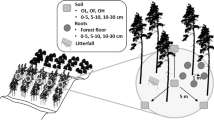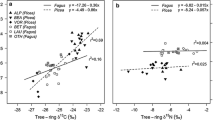Summary
Natural carbon and nitrogen isotope ratios were measured in different compartments (needles and twigs of different ages and crown positions, litter, understorey vegetation, roots and soils of different horizons) on 5 plots of a healthy and on 8 plots of a declining Norway spruce (Picea abies (L.) Karst.) forest in the Fichtelgebirge (NE Bavaria, Germany), which has recently been described in detail (Oren et al. 1988a; Schulze et al. 1989). The δ13C values of needles did not differ between sites or change consistently with needle age, but did decrease from the sun-to the shade-crown. This result confirms earlier conclusions from gas exchange measurements that gaseous air pollutants did no long-lasting damage in an area where such damage was expected. Twigs (δ13C between-25.3 and-27.8‰) were significantly less depleted in 13C than needles (δ13C between-27.3 and-29.1‰), and δ13C in twigs increased consistently with age. The δ15N values of needles ranged between-2.5 and-4.1‰ and varied according to stand and age. In young needles δ15N decreased with needle age, but remained constant or increased in needles that were 2 or 3 years old. Needles from the healthy site were more depleted in 15N than those from the declining site. The difference between sites was greater in old needles than in young ones. This differentiation presumably reflects an earlier onset of nitrogen reallocation in needles of the declining stand. δ15N values in twigs were more negative than in needles (-3.5 to-5.2‰) and showed age- and stand-dependent trends that were similar to the needles. δ15N values of roots and soil samples increased at both stands with soil depth from-3.5 in the organic layer to +4‰ in the mineral soil. The δ15N values of roots from the mineral soil were different from those of twigs and needles. Roots from the shallower organic layer had values similar to twigs and needles. Thus, the bulk of the assimilated nitrogen was presumably taken up by the roots from the organic layer. The problem of separation of ammonium or nitrate use by roots from different soil horizons is discussed.
Similar content being viewed by others
References
Benner R, Fogel ML, Sprague EK, Hodson RE (1987) Depletion of 13C in lignin and its implications for stable carbon isotope studies. Nature 329: 708–710
Brugnoli E, Hubick KT, Caemmerer S von, Wong SC, Farquhar GD (1988) Correlation between the carbon isotope discrimination in leaf starch and sugars of C3 plants and the ratio of intercellular and atmospheric partial pressure of carbon dioxide. Plant Physiol 88: 1418–1424
Ehleringer JR, Field CB, Lin ZF, Kuo CY (1986) Leaf carbon isotope and mineral composition in subtropical plants along an irradience cline. Oecologia 70: 520–526
Eiden R (1989) Air pollution and deposition. Ecol Stud 77: 57–100
Farquhar GD, O'Leary MH, Berry JA (1982) On the relationship between carbon isotope discrimination and the intercellular carbon dioxide concentration in leaves. Aust J Plant Physiol 9: 121–137
Francey RJ, Gifford RM, Sharkey TD, Weir B (1985) Physiological influences on carbon discrimination in huon pine (Lagarostrobos franklinii). Oecologia 66: 211–218
Kaupenjohann M (1989) Effects of acid rain on soil chemistry and nutrient availability in the soil. Ecol Stud 77: 297–341
Krouse HR (1989) Sulfur isotope studies of the pedosphere and biosphere. Ecol Stud 68: 424–444
Lange OL, Heber U, Schulze ED, Ziegler H (1989) Atmospheric pollutants and plant metabolism. Ecol Stud 77: 238–273
Mariotti A, Pierre D, Vedy JC, Bruckert S, Guillemot J (1980) The abundance of natural nitrogen 15 in the organic matter of soils along an altitudinal gradient (Chablais, Haute Savoie, France). Catena 7: 293–300
Mariotti A, Mariotti F, Champigny ML, Amarger N, Moyse A (1982) Nitrogen isotope fractionation associated with nitrate reductase activity and uptake of NO sup-inf3 by pearl millet. Plant Physiol 69: 880–884
Medina E, Minchin P (1980) Stratification of δ13C values of leaves in Amazonian rain forest. Oecologia 45: 377–378
Nadelhoffer KJ, Fry B (1988) Controls on natural nitrogen-15 and carbon-13 abundances in forest soil organic matter. Soil Sci Soc Am J 52: 1633–1640
Norusis M (1987) SPSS/PC+. For the IBM PC/XT/AT. Chicago
O'Leary M (1987) Carbon isotope fractionation in plants. Phytochem 20:553–567
O'Leary M (1988) Carbon isotopes in phytosynthesis. BioSci 38:328–336
Oren R, Schulze ED, Werk KS, Meyer J Schneider BU, Heilmeier H (1988a) Performance of two Picea abies (L.) Karst. stands at different stages of decline. I. Carbon relations and stand growth. Oecologia 75:25–37
Oren R, Schulze ED, Werk KS, Meyer J (1988b) Performance of two Picea abies (L.) Karst. stands at different stages of decline. VII. Nutrient relations and growth. Oecologia 77:163–173
Riga A, Van Praag HJ, Brigode N (1971) Rapport isotopique naturel de l'azote dans quelques sols forestiers et agricoles de belgique soumis a divers traitements culturaux. Geoderma 6:213–222
Rundel PW, Ehleringer JR, Nagy KA (eds) (1989) Stable isotopes in ecological research. Ecol Stud 68
SAS Institute Inc. (1985) SAS User's Guide: Statistics, Version 5 Edition. Cary, NC
Schleser GH, Jayasekera R (1985) δ13C-variations of leaves in forests as an indication of reassimilated CO2 from the soil. Oecologia 65:536–542
Schneider BU, Meyer J, Schulze ED, Zech W (1989) Root and mycorrhizal development in healthy and declining Norway spruce stands. Ecol Stud 77:370–391
Schulze ED (1989) Air pollution and forest decline in a spruce (Picea abies) forest. Science 244:776–783
Schulze ED, Gebauer G (1989) Aufnahme, Abgabe und Umsatz von Stickoxiden, NH sup+inf4 und Nitrat bei Waldbäumen, insbesondere der Fichte. In: Reuther M, Kirchner M (eds) 1. Statusseminar der PBWU zum Forschungsschwerpunkt “Wald-schäden”, GSF München, pp 119–133
Schulze ED, Lange OL, Oren R (eds) (1989) Forest decline and air pollution. A study of spruce (Picea abies) on acid soils. Ecol Stud 77
Schulze ED, McCracken I, Zimmermann R, Benecke U (1990) Performance of two Picea abies (L.) Karst. stands at different stages of decline. VIII. Photosynthesis and nutrition under polluted and clean air conditions of Germany and New Zealand. Oecologia 82:158–161
Schearer G, Kohl DH (1986) N2-fixation in field settings: estimations based on natural 15N abundance. Aust J Plant Physiol 13:699–756
Shearer G, Duffy J, Kohl DH, Commoner B (1974) A steady-state model of isotopic fractionation accompanying nitrogen trans-formations in soil. Soil Sci Soc Amer Proc 38:315–322
Tieszen LL, Boutton TW (1989) Stable carbon isotopes in terrestrial ecosystem research. Ecol Stud 68:167–195
Virginia RA, Delwiche CC (1982) Natural 15N abundance of presumed N2-fixing and non-N2-fixing plants from selected ecosystems. Oecologia 54:317–325
Virginia RA, Jarrell WM, Rundel PW, Shearer G, Kohl DH (1989) The use of variation in the natural abundance of 15N to assess symbiotic nitrogen fixation by woody plants. Ecol Stud 68:375–394
Vitousek PM, Shearer G, Kohl DH (1989) Foliar 15N natural abundance in Hawaiian rainforest: patterns and possible mechanisms. Oecologia 78:383–388
Vogel JC (1978) Recycling of carbon in a forest environment. Oecol Plant 13:89–94
Winkler FJ, Wirth E, Latzko E, Schmidt HL, Hoppe W, Wimmer P (1978) Influence of growth conditions and development on δ13C values in different organs and constituents of wheat, oat and maize. Z Pflanzenphysiol 87:255–263
Ziegler H (1979) Diskriminierung von Kohlenstoff-und Wasserstoffisotopen: Zusammenhänge mit dem Photosyntheseme-chanismus und den Standortsbedingungen. Ber Deutsch Bot Ges 92:169–184
Zimmermann R (1990) Photosynthese und Transpiration von Picea abies (L.) Karst. bei unterschiedlichem Ernährungszustand im Fichtelgebirge (Nordostbayern). Dissertation, Bayreuth
Zimmermann R, Oren R, Schulze ED, Werk KS (1988) Performance of two Picea abies (L.) Karst. stands at different stages of decline. II. Photosynthesis and leaf conductance. Oecologia 76:513–518
Author information
Authors and Affiliations
Rights and permissions
About this article
Cite this article
Gebauer, G., Schulze, E.D. Carbon and nitrogen isotope ratios in different compartments of a healthy and a declining Picea abies forest in the Fichtelgebirge, NE Bavaria. Oecologia 87, 198–207 (1991). https://doi.org/10.1007/BF00325257
Received:
Accepted:
Issue Date:
DOI: https://doi.org/10.1007/BF00325257




